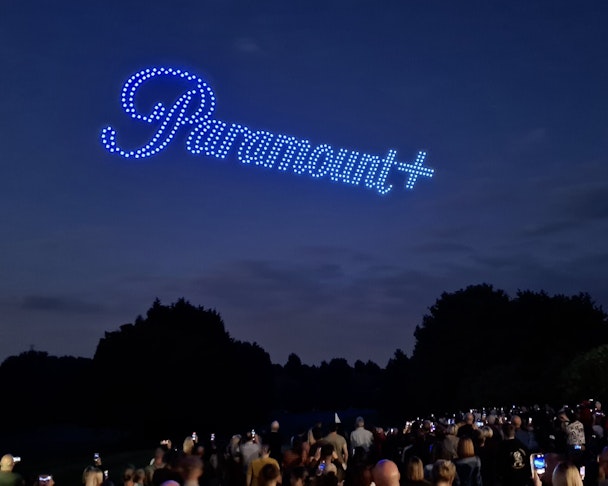With the buzz around drone shows, is the sky a new media channel?
Lou Kelly, head of consumer at Boldspace, has been keeping a close eye on the rise of drone-based PR. She sees them as a feasible media channel in 2023.

/ Sky Magic
Drone shows have emerged as a neat marketing tool for brands, especially Disney, Marvel, and Netflix, who have all used them to promote their films and TV series.
Using the sky as their canvas, they create inspiring and thought-provoking performances for audiences. With the sky becoming another channel in the marketing mix, like anything, what you do with it counts. Putting on a drone show comes with its limitations, and as such, advertisers need to be bolder and braver to embrace it fully.
The buzz needs to live longer than the shows
More advertisers embrace drone shows if they utilize them to their full potential and use them as a medium for storytelling.
Working in an agency myself, I see red flags when clients want to spend big on premium technology like a drone show, push for as much branding as possible (due to the cost) and expect everyone to care.
They might, but only if it tells a story.
The technology is not new news
When drone shows first started appearing, the technology itself was novel, but to keep it fresh, you need to be creative and find new things to say.
Yes, millions worldwide have yet to see a drone show firsthand, but simply lighting up the sky with your brand and product is not enough to get the media to write about it – you need to give people a reason to care.
You must deliver an emotional impact that will be shared and engaged with via a digital format.
Logistical challenges remain a barrier
Due to battery life, the average drone show is around eight minutes long. While there are ways in which you can creatively lengthen a performance, and the technology is becoming ever more sophisticated, the fact remains that it is only in public view for a relatively short period.
Furthermore, drone shows only work at night. It’s easier in the winter when it is darker earlier, but unless you are going to a planned exhibition, if you are anything like me, you’re not walking around at night waiting to be interrupted by a brand’s ad in the sky. And those who aren’t tucked up indoors will likely wander in locations where you have things such as building proximities and flight path restrictions to navigate, making it harder to put on a show.
Advertisers must plan to reach beyond the ground.
For brands to get actual value from a drone show, they need to plan to reach those who are not on the ground, those they can contact second-hand via social, owned channels and make it newsworthy enough to drive mainstream pickup.
But grabbing consumers’ attention and getting that media cut-through works the same way in the sky as underneath it. The creative needs to work hard to earn it.
You cannot play it safe
I spoke to drone art specialists Celestial, a British-born drone art display company that has worked on global projects with Amazon and Greenpeace. It was also commissioned to mark London’s New Year’s Eve celebrations last year.
Co-founder and CEO Tony Martin said: “We’re seeing more appetite from brands to create drone shows. The opportunity for drone light shows to supersede traditional fireworks displays is still very much on the global green agenda. This, coupled with the fact the technology is always advancing, means that there will always be a new way in which drone shows can be used for marketing and to keep surprising audiences and leave a lasting memory – far longer than a clever billboard that consumers may or may not even see.”
Tony told me that when it works with clients, the team thinks about the emotional impact as the starting point to any objectives, saying it is “the key to getting a story that lives on with the brand.”
It’s this storytelling element that is fundamental. After all, stories are designed to be retold and shared – brand logos are not.
“One of our key objectives, and something we measure our shows on, is whether or not we made people cry. It’s that sort of measurement that tells us whether our creative, our storytelling, hit the mark and delivered a spectacle that will truly stay in the memory forever”, Tony added.
Technology is rapidly evolving: fast forward ten years, and it’s not inconceivable that ‘ads’ in the sky’ will be the norm if they can remain up there longer. But for now, advertisers must push the boundaries to captivate mass audiences. In short… Avoid gimmicks, tell a story – be bold. Focus on these first, not how big your logo should be to be seen in the sky. Do this, and your drone show will fly!

